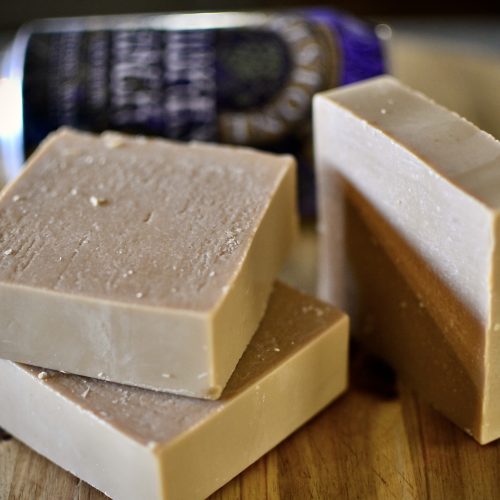
Beer Soap Experiment
Equipment
- Long Sleeve Shirt,Long Pants, Closed Toes Shoes
- Eye Protection / Googles
- Gloves
- Stick Blender / Emulsifying Blender
- Heat Resistant Bowl and Spatula
Ingredients
- 8 oz Coconut Oil (24%)
- 7.5 oz Olive Oil (22%)
- 7.5 oz Sweet Almond Oil (22%)
- 5 oz Mango Butter (12.1%)
- 6 oz Refined Shea Butter (19.9%)
Lye Water
- 4.8 oz Lye
- 24 oz Firestone Walker Wookey Jack Rye IPA or favorite beer
Instructions
- THIS IS IMPORTANT STEPBoil the beer for 20 to 30 minutes or until beer is completely flat. No carbonation should be left in the beer. Once beer is flat, measure 11.2 oz on the boiled beer.
- Put beer in refrigerator overnight. This is to prevent sugars in the beer from scorching when adding the Lye.
- Slowly and carefully add 4.8 ounces of Lye to 11.2 ounces of boiled beer, NEVER THE OTHER WAY AROUND, and gently stir until the Lye has fully dissolved and the liquid is clear. Set aside to cool. Optional: Add 2 teaspoons of sodium lactate to help the bars harden more quickly.
- Melt and measure the coconut oil, olive oil, sweet almond oil, mango butter and shea butter into the large heat-safe container. Allow the Lye water and the oils to cool to 130° F or below (and ideally within 10 degrees of each other). For this recipe, both were around 120° F.
- Place your stick blender into the bowl. Gently tap it on the bottom several times to release any bubbles that got trapped by the stick blender head. This is called “burping."
- Once bubbles no longer rise to the surface, gently pour the lye water into the bowl.
- Turn on the stick blender and pulse several times. You'll immediately see the lye and oils come together and create a creamy yellow color. Alternate between pulsing the stick blender and using it to stir. After about 30 seconds, test for trace. Because this recipe contains a large amount of olive oil, it will stay thin longer than recipes with fast-moving oils.
- Add fragrance (optional) Keep pulsing and stirring with the stick blender.
- You may notice the soap starting to lighten in color. It will also get thicker. The soap should be thick enough to support the trailings on the surface and the consistency is slightly thinner than pudding. This is perfect for pouring.
- Pour the soap into the mold. Scrape the sides of the bowl so you get every last bit!
- Firmly tap the box on the counter to pop any air bubbles. Spray the top with 99% isopropyl alcohol to help prevent soda ash.Allow the soap to sit in the mold for 3-4 days. Unmold, cut into bars, and let them cure for 4-6 weeks. Cure the soap in a cool, dry place with plenty of airflow. That allows excess water to evaporate, which makes the bars firmer and last longer in the shower.
Notes
Recipe adapted from Bramble Berry
Basic Terms
- Saponification: The chemical reaction that occurs when oil and lye molecules create new soap molecules.
- Trace: The point when oils and lye water emulsify and begin to thicken. Once the soap has reached thin trace, it will continue to thicken as it sits. Click here to learn more and to see examples of thin, medium, and thick trace.
- Emulsify: When the oils and lye solution mix and don't separate. The term emulsify and trace are often used interchangeably.
- Superfat: Any extra oil that's not turned into soap. Learn more in Superfatting Soap - An Explanation.
- Gel phase: "Gelling" or "gel phase" refers to when the soap gets warm and gelatinous – up to 180° F. Gel phase results in brighter colors and a shinier, more translucent appearance. Click here to learn more about gel phase.
- Soda ash: When unsaponified lye reacts with naturally-occurring carbon dioxide in the air and creates a white ashy film on the bars. It only affects the way the soap looks, not the quality. Learn more in Explaining and Preventing Soda Ash.